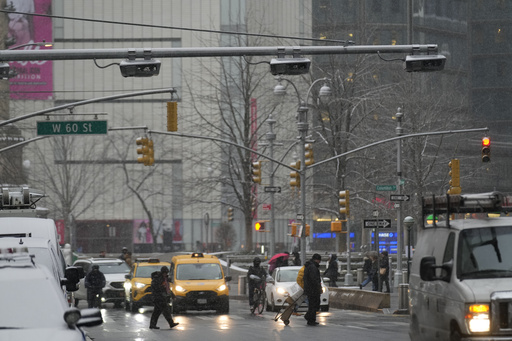NEW YORK — A recent toll implemented on vehicles entering the heart of Manhattan has led to a noticeable, although modest, decrease in traffic congestion within New York City’s heavily congested streets during its initial week of operation, as indicated by preliminary data from the state’s transit authority.
This innovative approach, termed “congestion pricing,” commenced on January 5, with most passenger vehicles facing a fee of $9 while entering below Central Park during peak hours, and higher charges applied to trucks and other larger vehicles. The Metropolitan Transportation Authority (MTA) reported that vehicle entries into the tolling zone have diminished by 7.5%, translating to approximately 43,000 fewer cars each day compared to similar days from the previous year.
“Take a look outside; you can see there’s less traffic and quieter streets, an outcome everyone seems to have noticed,” commented Juliette Michaelson, the MTA’s deputy chief of policy and external relations. “Traffic patterns are shifting and will continue to evolve.”
Originally proposed many years ago, the program aims to generate substantial revenue for the financially strapped MTA while alleviating congestion on the city’s busy roads. This initiative is aligned with similar strategies seen in cities like London, Singapore, and Stockholm, which all experienced immediate traffic reductions after implementing their respective toll systems.
The impact in New York has been particularly evident during the morning rush hour, where travel times over certain crossings—especially the often congested Holland and Lincoln tunnels that connect to New Jersey—have decreased by 40% or more, according to Michaelson.
While there have been reports of increased overcrowding on trains, officials noted that there hasn’t been a significant rise in subway ridership, largely because the baseline is already over 3 million daily riders. However, some bus routes originating from Brooklyn and Staten Island experienced a surge in passengers the previous week.
Within the congestion pricing zone, the immediate effects have been varied. While some major routes witnessed a drop in traffic, others remained relatively unchanged. An often criticized Midtown crosstown bus saw only a minute reduction in travel time, as per MTA reports. Notably, there has been minimal change during the overnight hours, as the toll for passenger vehicles decreases to $2.25, officials have acknowledged.
Bob Pishue, a traffic analyst at INRIX, which tracks traffic data, suggested that the MTA’s initial outcomes were consistent with his firm’s observations, where they analyzed GPS data from drivers before and after the toll implementation. “There are fewer vehicles entering Manhattan, but we are not yet seeing a significant effect on travel speeds within the zone,” he remarked. “While some journeys are quicker, others may take longer.”
He advised caution in drawing definitive conclusions after just one week, noting that many drivers might be adopting a “wait and see” strategy.
Congestion pricing has created a division among residents of New York and surrounding areas, sparking protests from numerous drivers, alongside threats to sabotage the program and viral video tutorials on evasion tactics. Conversely, supporters have celebrated the launch as a pivotal moment for a city grappling with escalating traffic issues and an aging public transit infrastructure in dire need of refurbishment.
Originally set to start in June, the program faced a last-minute suspension by New York Governor Kathy Hochul. Although she had previously been supportive, her stance shifted after discussions with “ordinary” New Yorkers, including concerns voiced by a Manhattan diner proprietor about potential negative impacts on customers driving in from New Jersey.
Eventually, Hochul reinstated the program but adjusted the toll to a lower fee of $9 for most drivers, down from $15 that the state first approved.
Tarek Soliman, who owns Comfort Diner in midtown Manhattan, shared that he had communicated directly with the governor regarding his apprehensions about losing customers from New Jersey. Although he felt it was premature to assess the toll’s impact on his business, he acknowledged a change in his own habits: “Previously, I would drive to the garage next to the diner each weekend. Now, I opt for the subway.”

